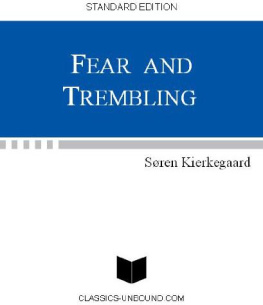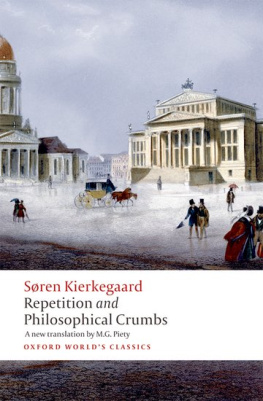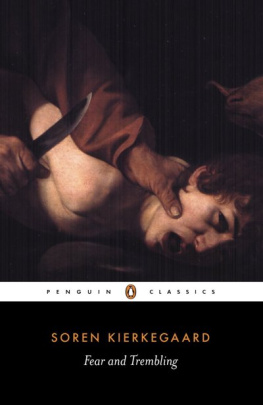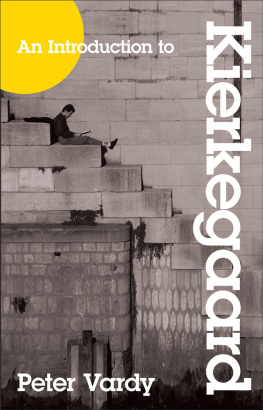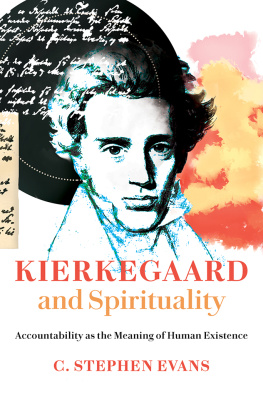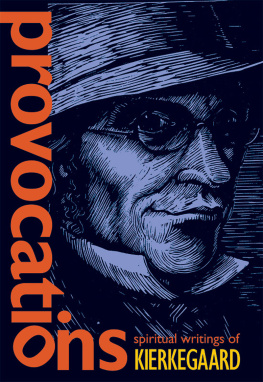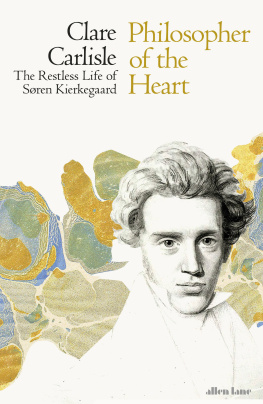KIERKEGAARDS UPBUILDING DISCOURSES
There is little doubt as to Kierkegaards importance in the story of modern European thought. Once described as the leader of modernitys awkward squad, he formulated a set of concepts and concerns that have been revisited many times in the more than one hundred and fifty years since his death. It has undoubtedly been at times of crisisof which there have been not a few in this periodthat he has especially come into his own, times when prevailing systems and worldviews have collapsed under the weight of modernitys complex and contradictory demands, and when culture, intellectual life, and religion have come to the brink of disintegration. If we wanted to pinpoint Kierkegaards contribution to the history of modern ideas, then, it would be natural to look to such characteristically Kierkegaardian terms as melancholy, irony, anxiety, the absurd, the para dox, the leap of faith, the moment, and despair. Kierkegaard did not, of course, invent these terms, but he gave them new meanings and fresh currency, and his way of using them would be taken up into the philosophy of existence and the theology of crisis in the 1920s and pass from there into French existentialism and, later, postmodernism. But while this history of reception is not entirely unconnected to Kierkegaard, it represents only a part of what was going on in his authorship andon his own accountnot the most important part. In fact, we could go so far as to say that the Kierkegaard known to the history of modern ideas is, in an important sense, not Kierkegaard at all.
The main discussions of nearly all the terms listed above, along with many of the best-known images, stories, and dramatizations by which he brought the abstract terminology of postidealist philosophy to life, are found in works that he published under a series of strange pseudonyms and that, he repeatedly said, by no means represented his own point of view. And while it is also true to say that his journals played an important part in shaping our image of Kierkegaard, these have often been presented in selections that reveal an all too biased editorial handa comment that applies equally to selections in Danish, English, French, and German. Where, then, is Kierkegaards true point of view to be found? He himself consistently claimed that it was not to be found in such pseudonymous works as Either/Or, Fear and Trembling, Stages on Lifes Way, Philosophical Fragments, or The Sickness unto Death but in the religious writings he published under his own name and which he called upbuilding (or edifying") discourses and, sometimes, Christian discourses.
What is the difference between these two groups of writings? It is not that the former deal with topics such as music, literature, seduction, and unhappy love affairs while the latter speak about prayer, worship, and other religious matters. Religion is already a prominent theme in the pseudonymous works, whether in terms of the comfortable Biedermeier religiosity of Assessor Vilhelm in Either/Or, the paradoxical faith of Johannes Climacus (the pseudonymous author of Philosophical Fragments), or the extreme Christianity of Kierkegaards last pseudonym, Anti-Climacus, who professed a radical version of Christianity that Kierkegaard declared himself unable to live up to. So there is plenty of religion in the pseudonymous works, but even when it is specifically called Christianity, it is generally presented by the pseudonyms in terms of a thought experiment, as one possibility among others that the reader is invited to contemplate and play with, but without regard to putting it into practice. This is very different in the case of Kierkegaards discourses. These are modeled on contemporary printed sermons, and, as such, they presume that the reader is someone who is serious about living religiously. Readers are repeatedly addressed as You and invited to give their own response to what the authoror, as he often refers to himself, the speaker"is proposing. Everything is to be tested against our life experience and, if it fits, to be applied in life or, to use that characteristically Kierkegaardian term, existence. The discourses are not thought experiments but offer real input into real problems.
Yet they are not exactly like the sermons on which, in literary terms, they model themselves. For, unlike a preacher, Kierkegaard does not presume to stand in a relation of authority to his readers. He cannot tell them what to believe or do, he can only seek to persuade them or to recommend a new way of looking at their lives and the challenges they face. So here, too, as in the pseudonymous works, there is a kind of indirect communication, a play of possibilities that gives scope for imaginative invention and transformationnot least, as we shall see, when Kierkegaard takes up the theme of the lilies and the birds mentioned in the Sermon on the Mount and turns them into teachers who lead their students into a world sometimes resembling that of Hans Christian Andersens fairy tales. The discourses are not plodding expositions of ready-made dogmas but have an almost conversational feel, sometimes serious, sometimes playful, but always seeking to open a dialogue with the reader, whose own response is anticipated and responded to.
Like many authors, including authors of prose fiction, Kierkegaard may be said to construct his reader, to assume a certain set of commitments and attitudes that he then engages and either challenges or helps the reader deepen and develop. But what if these are not our commitments and attitudes? What if you do not recognize yourself in Kierkegaards imagined reader? After all, it is rather well known that fewer people today class themselves as Christian believers than in Kierkegaards time, and many say they have no belief at all. Even among the believers, many of the ways in which Christianity is formulated and expressed today differ considerably from those familiar to the mid-nineteenth-century Danish Lutherans who were Kierkegaards first readers. And today, there will also be many readers of Kierkegaard who, if they are religious, belong to religious traditions other than Christianity. If the lack of religious commitment in the pseudonymous works allows them to speak to our arguably post-Christian age, what about the discourses? How can those who do not share Kierkegaards religious assumptions find a way into these avowedly religious works and benefit from them?
As a first step to answering this important question we should note that Kierkegaard typically uses one of two designations for these discourses. Sometimes he calls them upbuilding or edifying discourses and sometimesonly sometimesspecifically Christian discourses. Broadly speaking (there are exceptions), it is the earlier discourses that are described as upbuilding, while the later ones are more frequently called Christian. This progression corresponds to the development that Kierkegaard claimed was also to be seen in the movement of the pseudonymous authorship, namely, a movement from the rather diffuse aesthetic or ethical worldview of his contemporaries to a more decisively religious position and then on to a specifically Christian life of faith and discipleship. With regard to the upbuilding discourses themselves, Kierkegaards own pseudonymous author Johannes Climacus wrote that they are not in fact Christian in an emphatic sense, since they do not assume the authority either of Christ or of Scripturein fact, he claims, they do not even mention Christ or deploy Christianitys distinctively paradoxical concepts. All they assume, he implies, is that they are addressed to readers who are ready to take seriously the possibility of religion. But how much (or how little) does that involve?


